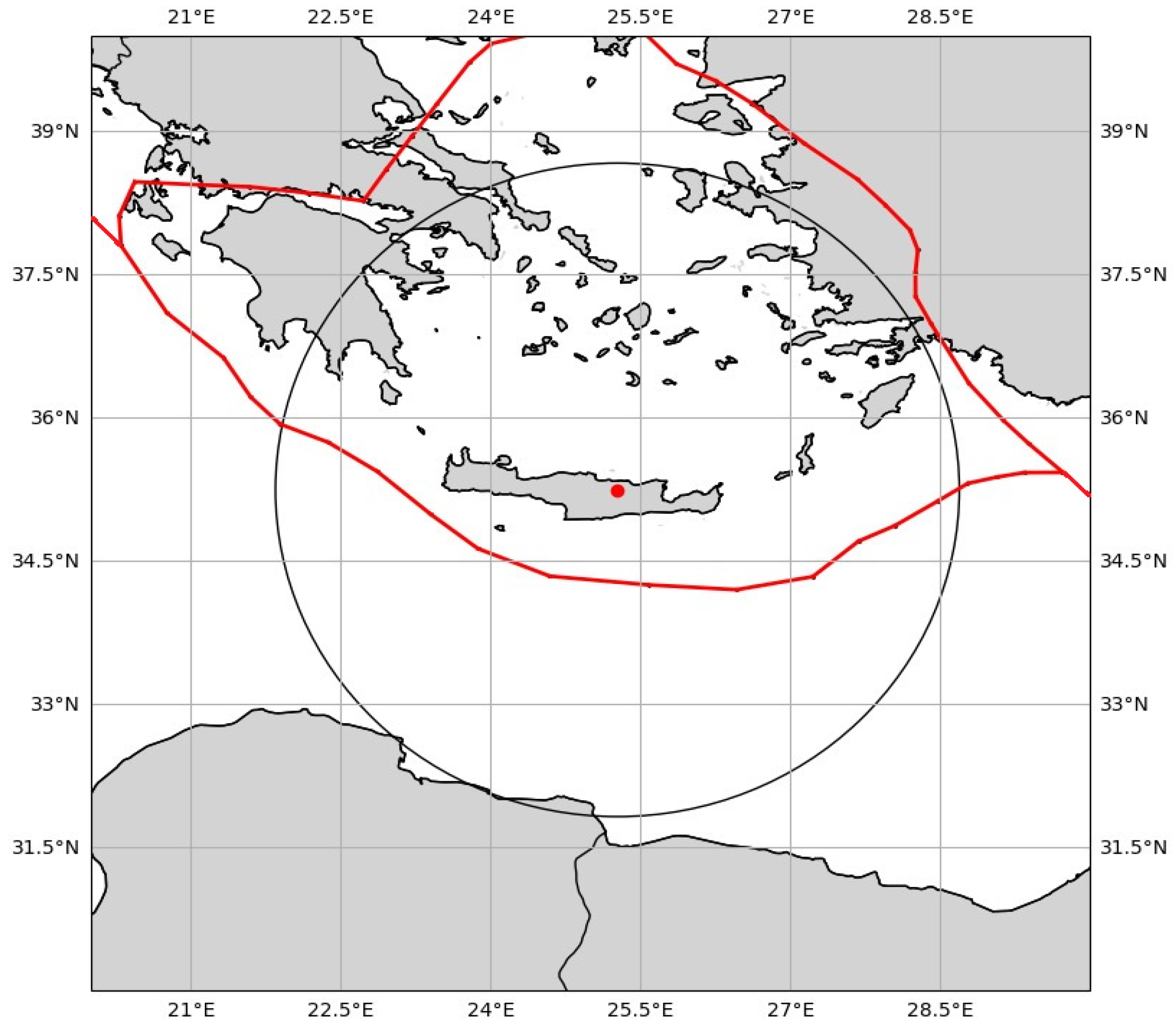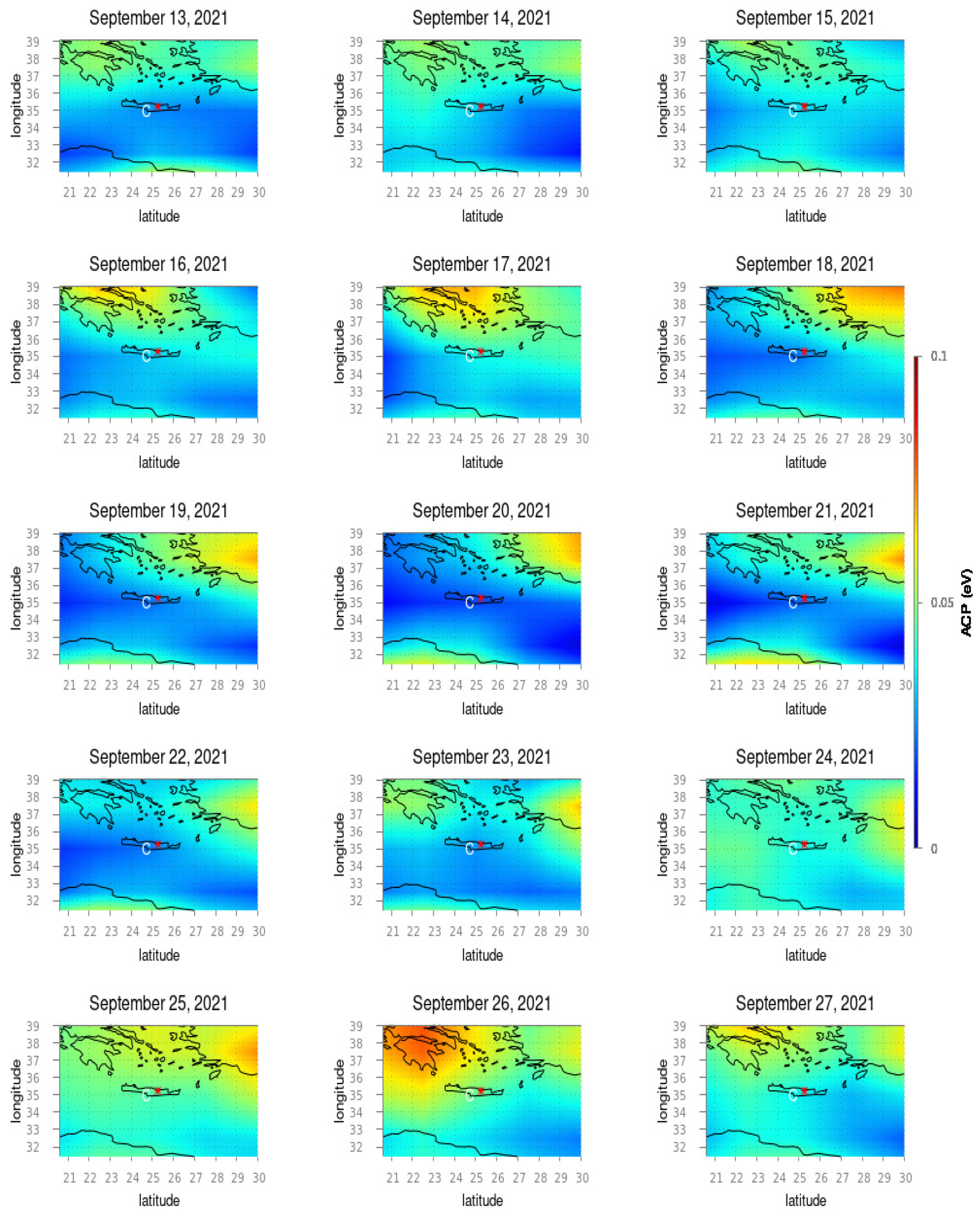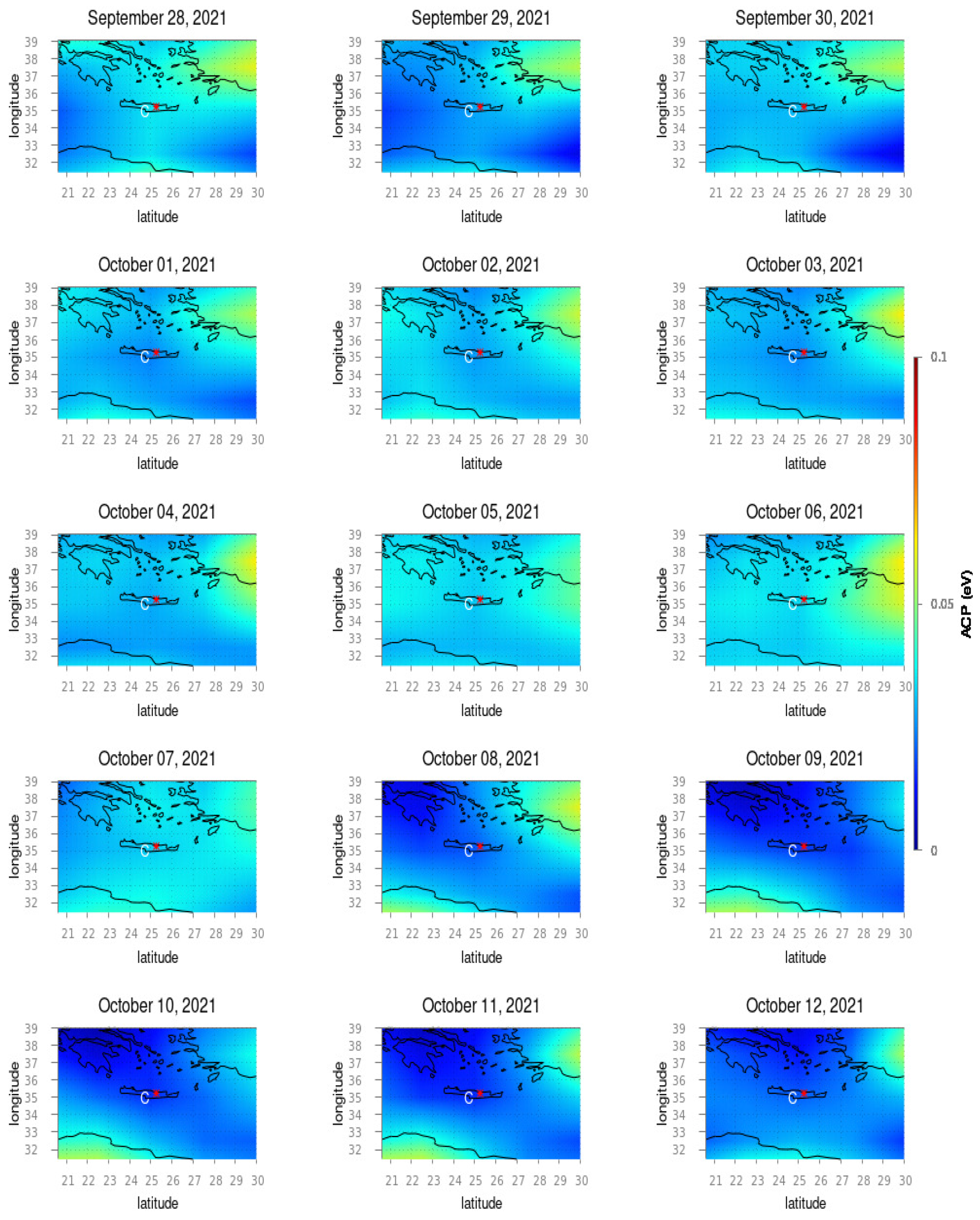Thermal Anomalies Observed during the Crete Earthquake on 27 September 2021
Abstract
:1. Introduction
2. Data and Methodologies
2.1. Surface Latent Heat Flux Anomaly
2.2. Outgoing Longwave Radiation Data Analysis
2.3. Atmospheric Chemical Potential Analysis
3. Results
3.1. Surface Latent Heat Flux Observational Results
3.2. OLR Results
3.3. ACP Variation
4. Discussion
- (i)
- It is evident from Figure 2 that the intensification in the SLHF is observed on 23 and 24 September 2021 over the epicenter region. The intensified SLHF shows a longitudinal spread over the earthquake epicenter and migrates towards the southeast direction. After the earthquake, comparatively less intensification is observed from 29 September to 6 October 2021 (Figure 2). For all these days, the anomalies are observed mostly in the north–south direction over the epicenter. This can be attributed to the combined effects of a series of aftershocks of the mainshock of 27 September and a second mainshock that took place on 12 October 2021, south-southeast of Crete island, the epicenter of which was in close vicinity of the first mainshock.
- (ii)
- In contrast to the SLHF, the intensification in the OLR Eddy Field was observed from 18 to 21 September 2021, in two different patches in the northeast and northwest directions of the epicenter, which lie within the earthquake preparation zone (Figure 4). On 23 and 24 September, it became a single intensification over the epicenter, similar to the SLHF variation. After the Crete earthquake, a similar post-earthquake OLR Eddy field enhancement was observed with much less intensity (Figure 5). On 12 September 2021, the Eddy Field again increased in the northern direction of the epicenter, possibly due to the second mainshock mentioned above.
- (iii)
- The ACP variation shows an anomalous increase from 16 September, and the maximum enhancement took place on 21 September 2021 (Figure 6). During this period, the intensification of the ACP is found to be a bit away from the epicenter of the 2021 Crete earthquake. On 26 September, a secondary enhancement was observed near the earthquake epicenter. For the ACP, no such post-earthquake enhancement is observed, in contrast to the SLHF and OLR.
5. Conclusions
Author Contributions
Funding
Data Availability Statement
Acknowledgments
Conflicts of Interest
References
- Pulinets, S.; Boyarchuk, K. Ionospheric Precursors of Earthquakes; Springer: Berlin/Heidelberg, Germany; New York, NY, USA, 2004; ISBN 3. [Google Scholar] [CrossRef]
- Molchanov, O.A.; Hayakawa, M. Seismo Electromagnetics and Related Phenomena: History and Latest Results; TERRAP: Tokyo, Japan, 2008; 189p. [Google Scholar]
- Ouzounov, D.; Pulinets, S.; Hattori, K.; Taylor, P. (Eds.) Pre-Earthquake Processes: A Multidisciplinary Approach to Earthquake Prediction Studies; AGU Geophysical Monograph; Wiley: Hoboken, NJ, USA, 2018; Volume 234, 365p. [Google Scholar]
- Nayak, K.; López-Urías, C.; Romero-Andrade, R.; Sharma, G.; Guzmán-Acevedo, G.M.; Trejo-Soto, M.E. Ionospheric Total Electron Content (TEC) Anomalies as Earthquake Precursors: Unveiling the Geophysical Connection Leading to the 2023 Moroccan 6.8 Mw Earthquake. Geosciences 2023, 13, 319. [Google Scholar] [CrossRef]
- Sharma, G.; Saikia, P.; Walia, D.; Banerjee, P.; Raju, P.L.N. TEC anomalies assessment for earthquakes precursors in North-Eastern India and adjoining region using GPS data acquired during 2012–2018. Quat. Int. 2021, 575, 120–129. [Google Scholar] [CrossRef]
- Molchanov, O.A. Lithosphere-Atmosphere-Ionosphere Coupling due to Seismicity. Electromagn. Phenom. Assoc. Earthq. 2009, 255–279. [Google Scholar]
- Pulinets, S.; Ouzonov, D. Lithosphere-Atmosphere-Ionosphere Coupling (LAIC) model-An unified concept for earthquake precursors validation. J. Asian Earth Sci. 2011, 41, 371–382. [Google Scholar] [CrossRef]
- Omori, Y.; Yasuoka, Y.; Nagahama, H.; Kawada, Y.; Ishikawa, T.; Tokonami, S.; Shinogi, M. Anomalous radon emanation linked to preseismic electromagnetic phenomena. Nat. Hazards Earth Syst. Sci. 2007, 7, 629–635. [Google Scholar] [CrossRef]
- Klimenko, M.V.; Klimenko, V.V.; Zakharenkova, I.E.; Pulinets, S.A.; Zhao, B.; Tsidilina, M.N. Formation mechanism of great positive TEC disturbances prior to Wenchuan earthquake on May 12, 2008. Adv. Space Res. 2011, 48, 488–499. [Google Scholar] [CrossRef]
- Asano, T.; Hayakawa, M. On the tempo-spatial evolution of the lower ionospheric perturbation for the 2016 Kumamoto earthquakes from comparisons of VLF propagation data observed at multiple stations with wave-hop theoretical computations. Open J. Earthq. Res. (OJER) 2018, 7, 161–185. [Google Scholar] [CrossRef]
- Biswas, S.; Kundu, S.; Chowdhury, S.; Ghosh, S.; Yang, S.; Hayakawa, M.; Chakraborty, S.; Chakrabarti, S.; Sasmal, S. Contaminated effect of geomagnetic storm on pre-seismic atmospheric and ionospheric anomalies during imphal earthquake. Open J. Earthq. Res. (OJER) 2020, 9, 383–402. [Google Scholar] [CrossRef]
- Chakrabarti, S.K.; Sasmal, S.; Chakrabarti, S. Ionospheric anomaly due to seismic activities-II: Possible evidence from D-layer preparation and disappearance times. Nat. Hazards Earth Syst. Sci. 2010, 10, 1751–1757. [Google Scholar] [CrossRef]
- Chakraborty, S.; Sasmal, S.; Basak, T.; Ghosh, S.; Palit, S.; Chakrabarti, S.K.; Ray, S. Numerical modeling of possible lower ionospheric anomalies associated with Nepal earthquake in May, 2015. Adv. Space Res. 2017, 60, 1787–1796. [Google Scholar] [CrossRef]
- Chakraborty, S.; Sasmal, S.; Chakrabarti, S.K.; Bhattacharya, A. Observational signatures of unusual outgoing longwave radiation (OLR) and atmospheric gravity waves (AGW) as precursory effects of May 2015 Nepal earthquakes. J. Geodyn. 2018, 113, 43–51. [Google Scholar] [CrossRef]
- Ghosh, S.; Sasmal, S.; Midya, S.; Chakrabarti, S. Unusual Change in Critical Frequency of F2 Layer during and Prior to Earthquakes. J. Open Earthq. Res. (OJER) 2017, 6, 191–203. [Google Scholar] [CrossRef]
- Ghosh, S.; Chakraborty, S.; Sasmal, S.; Basak, T.; Chakrabarti, S.K.; Samanta, A. Comparative study of the possible lower ionospheric anomalies in Very Low Frequency (VLF) signal during Honshu, 2011 and Nepal, 2015 earthquakes. Geomat. Nat. Hazards Risk 2019, 10, 1596–1612. [Google Scholar] [CrossRef]
- Hayakawa, M.; Molchanov, O.A.; Ondoh, T.; Kawai, E. Anomalies in the sub-ionospheric VLF signals for the 1995 Hyogo-ken Nanbu earthquake. J. Phys. Earth 1996, 44, 413–418. [Google Scholar] [CrossRef]
- Hayakawa, M.; Molchanov, O.A.; Ondoh, T.; Kawai, E. The precursory signature effect of the Kobe earthquake on VLF subionospheric signals. J. Comm. Res. Lab. Tokyo 1996, 43, 169–180. [Google Scholar]
- Hayakawa, M.; Potirakis, S.M.; Saito, Y. Possible relation of air ion density anomalies with earthquakes and the associated precursory ionospheric perturbations: An analysis in terms of criticality. Int. J. Electron. Appl. Res. 2018, 5, 56–75. [Google Scholar] [CrossRef]
- Sasmal, S.; Chakrabarti, S.K. Ionosperic anomaly due to seismic activities—Part 1: Calibration of the VLF signal of VTX 18.2 kHz station from Kolkata and deviation during seismic events. Nat. Hazards Earth Syst. Sci. 2009, 9, 1403–1408. [Google Scholar] [CrossRef]
- Sasmal, S.; Chakrabarti, S.K.; Ray, S. Unusual behavior of Very Low Frequency signal during the earthquake at Honshu/Japan on 11 March, 2011. Indian J. Phys. 2014, 88, 1013–1019. [Google Scholar] [CrossRef]
- Ghosh, S.; Chowdhury, S.; Kundu, S.; Sasmal, S.; Politis, D.Z.; Potirakis, S.M.; Hayakawa, M.; Chakraborty, S.; Chakrabarti, S.K. Unusual Surface Latent Heat Flux Variations and Their Critical Dynamics Revealed before Strong Earthquakes. Entropy 2022, 24, 23. [Google Scholar] [CrossRef]
- Ghosh, S.; Sasmal, S.; Naja, M.; Potirakis, S.; Hayakawa, M. Study of aerosol anomaly associated with large earthquakes (M > 6). Adv. Space Res. 2022, 71, 129–143. [Google Scholar] [CrossRef]
- Pulinets, S.; Ouzounov, D.; Karelin, A.; Davidenko, D. Physical Bases of the Generation of Short Term Earthquake Precursors: A Complex Model of Ionization Induced Geophysical Processes in the Lithosphere–Atmosphere–Ionosphere–Magnetosphere System. Geomagn. Aeron. 2015, 55, 521–538. [Google Scholar] [CrossRef]
- Kondepudi, D.; Prigogine, I. Modern Thermodynamics: From Heat Engines to Dissipative Structures; Wiley: Chichester, UK, 1998. [Google Scholar]
- Pulinets, S.A.; Ouzounov, D.; Karelin, A.V.; Boyarchuk, K.A.; Pokhmelnykh, L.A. The physical nature of the thermal anomalies observed before strong earthquakes. Phys. Chem. Earth 2006, 31, 143–153. [Google Scholar] [CrossRef]
- Gorny, V.I.; Salman, A.G.; Tronin, A.A.; Shilin, B.V. The Earth’s outgoing IR radiation as an indicator of seismic activity. Proc. Acad. Sci. USSR 1988, 301, 67–69. [Google Scholar]
- Ouzounov, D.; Freund, F. Mid-infrared emission prior to strong earthquakes analyzed by remote sensing data. Adv. Space Res. 2004, 33, 268–273. [Google Scholar] [CrossRef]
- Qiang, Z.J.; Xu, X.D.; Dian, C.G. Abnormal infrared thermal satellite-forewarning of earthquakes. Chin. Sci. Bull. 1990, 35, 1324–1327. [Google Scholar]
- Saraf, A.K.; Choudhury, S. Satellite detects surface thermal anomalies associated with the Algerian earthquakes of May 2003. Int. J. Remote Sens. 2004, 26, 2705–2713. [Google Scholar] [CrossRef]
- Tronin, A.A. Satellite thermal survey—A new tool for the study of seismo active regions. Int. J. Remote Sens. 1996, 41, 1439–1455. [Google Scholar] [CrossRef]
- Tronin, A.A.; Hayakawa, M.; Molchanov, O.A. Thermal IR satellite data application for earthquake research in Japan and China. J. Geodyn. 2002, 33, 519–534. [Google Scholar] [CrossRef]
- Xu, X.; Qiang, Z.; Dian, C. Thermal infrared image of Meteosat and prediction of impending earthquake–conclusion of studying thermal infrared image before Lanhang-Genma earthquake occurring. Remote Sens. Environ. 1991, 6, 261–266. [Google Scholar]
- Pulinets, S.; Ouzounov, D.; Karelin, A.; Davidenko, D. Lithosphere-Atmosphere-Ionosphere-Magnetosphere Coupling—A Concept for Pre-Earthquake Signals Generation. In Pre-Earthquake Processes: A Multidisciplinary Approach to Earthquake Prediction Studies; Ouzounov, D., Pulinets, S., Hattori, K., Taylor, P., Eds.; AGU/Wiley: Washington, DC, USA, 2018; pp. 77–98. [Google Scholar]
- Pulinets, S.; Budnikov, P. Atmosphere Critical Processes Sensing with ACP. Atmosphere 2022, 13, 1920. [Google Scholar] [CrossRef]
- Politis, D.Z.; Potirakis, S.M.; Sasmal, S.; Malkotsis, F.; Dimakos, D.; Hayakawa, M. Possible Pre-Seismic Indications Prior to Strong Earthquakes That Occurred in Southeastern Mediterranean as Observed Simultaneously by Three VLF/LF Stations Installed in Athens(Greece). Atmosphere 2023, 14, 673. [Google Scholar] [CrossRef]
- Biswas, S.; Chowdhury, S.; Sasmal, S.; Politis, D.Z.; Potirakis, S.M.; Hayakawa, M. Numerical modelling of sub-ionospheric Very Low Frequency radio signal anomalies during the Samos (Greece) earthquake (M = 6.9) on October 30, 2020. Adv. Space Res. 2022, 70, 1453–1471. [Google Scholar] [CrossRef]
- Chowdhury, S.; Kundu, S.; Ghosh, S.; Hayakawa, M.; Schekotov, A.; Potirakis, S.M.; Chakrabarti, S.K.; Sasmal, S. Direct and indirect evidence of pre-seismic electromagnetic emissions associated with two large earthquakes in Japan. Nat. Hazards 2022, 112, 2403–2432. [Google Scholar] [CrossRef]
- Hayakawa, M.; Schekotov, A.; Izutsu, J.; Yang, S.-S.; Solovieva, M.; Hobara, Y. Multi-Parameter Observations of Seismogenic Phenomena Related to the Tokyo Earthquake (M = 5.9) on 7 October 2021. Geosciences 2022, 12, 265. [Google Scholar] [CrossRef]
- Kundu, S.; Chowdhury, S.; Ghosh, S.; Sasmal, S.; Politis, D.Z.; Potirakis, S.M.; Yang, S.S.; Chakrabarti, S.K.; Hayakawa, M. Seismogenic Anomalies in Atmospheric Gravity Waves as Observed from SABER/TIMED Satellite during Large Earthquakes. J. Sens. 2022, 2022, 3201104. [Google Scholar] [CrossRef]
- Sasmal, S.; Chowdhury, S.; Kundu, S.; Politis, D.Z.; Potirakis, S.M.; Balasis, G.; Hayakawa, M.; Chakrabarti, S.K. Pre-Seismic Irregularities during the 2020 Samos (Greece) Earthquake (M = 6.9) as Investigated from Multi-Parameter Approach by Ground and Space-Based Techniques. Atmosphere 2021, 12, 1059. [Google Scholar] [CrossRef]
- Kang, C.; Liu, D. The applicability of satellite remote sensing in monitoring earthquake. Sci. Surv. Mapp. 2001, 26, 46–48. [Google Scholar]
- Liu, D.; Peng, K.; Liu, W.; Li, L.; Hou, J. Thermal omens before earthquake. Acta Seismol. Sin. 1999, 12, 710–715. [Google Scholar] [CrossRef]
- Liu, D. Anomalies analyses on satellite remote sensing OLR before Jiji earthquake of Taiwan Province. Geo-Inf. Sci. 2000, 2, 33–36. [Google Scholar]
- Xiong, P.; Shen, X.H.; Bi, Y.X.; Kang, C.L.; Chen, L.Z.; Jing, F.; Chen, Y. Study of outgoing longwave radiation anomalies associated with Haiti earthquake. Nat. Hazards Earth Syst. Sci. 2010, 10, 2169–2178. [Google Scholar] [CrossRef]
- Boyarchuk, K.A.; Karelin, A.V.; Shirokov, R.V. Bazovaya Model’ Kinetiki Ionizirovannoi Atmosfery (The Reference Model of Ionized Atmospheric Kinetics); VNIIEM: Moscow, Russia, 2006. [Google Scholar]
- Yang, S.S.; Potirakis, S.M.; Sasmal, S.; Hayakawa, M. Natural Time Analysis of Global Navigation Satellite System Surface Deformation: The Case of the 2016 Kumamoto Earthquakes. Entropy 2020, 22, 674. [Google Scholar] [CrossRef]
- Aubry, J.; Passelègue, F.X.; Deldicque, D.; Girault, F.; Marty, S.; Lahfid, A.; Bhat, H.S.; Escartin, J.; Schubnel, A. Frictional Heating Processes and Energy BudgetDuring Laboratory Earthquakes. Geophys. Res. Lett. 2018, 12, 274. [Google Scholar]
- Coffey, J.L.; Savage, H.M.; Polissar, P.J. Estimates of earthquake temperature rise, frictional energy, and implications to earthquake energy budgets. Seismica 2023, 2. [Google Scholar] [CrossRef]







| Earthquake | Location of Epicenter | Magnitude () | Depth (km) | Date and Time (UT) | Radius of Preparation Zone (km) |
|---|---|---|---|---|---|
| Crete Earthquake | 35.244° N 25.27° E | 6 | 6 | 27 September 2021 06:17:21 | 380.189 |
Disclaimer/Publisher’s Note: The statements, opinions and data contained in all publications are solely those of the individual author(s) and contributor(s) and not of MDPI and/or the editor(s). MDPI and/or the editor(s) disclaim responsibility for any injury to people or property resulting from any ideas, methods, instructions or products referred to in the content. |
© 2024 by the authors. Licensee MDPI, Basel, Switzerland. This article is an open access article distributed under the terms and conditions of the Creative Commons Attribution (CC BY) license (https://creativecommons.org/licenses/by/4.0/).
Share and Cite
Ghosh, S.; Sasmal, S.; Maity, S.K.; Potirakis, S.M.; Hayakawa, M. Thermal Anomalies Observed during the Crete Earthquake on 27 September 2021. Geosciences 2024, 14, 73. https://doi.org/10.3390/geosciences14030073
Ghosh S, Sasmal S, Maity SK, Potirakis SM, Hayakawa M. Thermal Anomalies Observed during the Crete Earthquake on 27 September 2021. Geosciences. 2024; 14(3):73. https://doi.org/10.3390/geosciences14030073
Chicago/Turabian StyleGhosh, Soujan, Sudipta Sasmal, Sovan K. Maity, Stelios M. Potirakis, and Masashi Hayakawa. 2024. "Thermal Anomalies Observed during the Crete Earthquake on 27 September 2021" Geosciences 14, no. 3: 73. https://doi.org/10.3390/geosciences14030073







